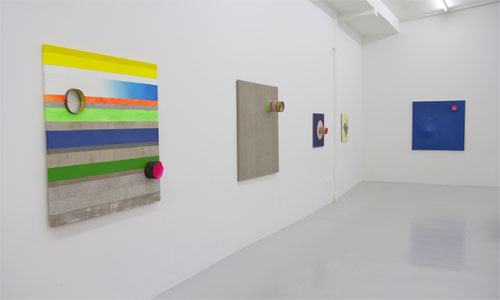PAINTING INTO 3 DIMENSIONS – GALERIE RICHARD
PAINTING INTO 3 DIMENSIONS
Linda Besemer
Bram Bogart
Sven-Ole Frahm
Ron Gorchov
Norio Imai
Takesada Matsutani
David Ryan
Galerie Richard is pleased to host the exhibition “Painting Into Three Dimensions” from March 12th to April 30th 2016. This is a continuation of the exhibition at Galerie Richard in New York in February 2016. The exhibit highlights the importance of the painter working in three dimensions. The exhibition gathers different generations of artists from Europe, North America, and Asia that have been supported by the gallery: Linda Besemer, Bram Bogart, Sven-Ole Frahm, Ron Gorchov, Norio Imai, Takesada Matsutani et David Ryan.
Bram Bogart was most influenced by Van Gogh, who applied a touch of texture for each color. In 1960, besides beginning to work on ground, he applied jute fabric to panels and further strengthened the back of the paintings with wooden crosspieces. He observed that the thicker the material is, the more variations he could create in gestures, signs, and strips. He considers himself a painter, not a sculptor, saying: “There is no dimension related to sculpture in my works. The third dimension is the depth of the paint layer.”
In 1966, Ron Gorchov made the first negatively curved structure with a wire dipped into a plastic liquid. He realized that as the whole thing got stronger, it could make less acute corners. He finally discovered the best method was to start with a rectangle, so the curved part would spring away from it. Therefore, the structure itself becomes an argument to the rectangle. This concept interested him.
In the 1950’s, Takesada Matsutani, a Gutai artist, was interested in the organic forms of cells that he could watch with a microscope. Accidentally, he noticed that the wood glue that he poured on a canvas dried on the surface and formed a texture like skin. He blew the air inside with a straw and the surface of the skin swelled and became a soft globe. He also created waving shapes by pouring the glue and using a roller on the canvas. He wishes “to instill his sense of sensuality in his artworks.”
Another Japanese artist, Norio Imai, also part of the Gutai movement, developed the third dimension in the 1960’s. From the beginning he added molded three-dimensional plastic shapes to white painted canvas and stretchers. For him, the canvas is not so much a support for the painting, but a new medium that allows him to experiment and develop his paintings in three dimensions. By doing so, he plays with light and adds tonality to the monochrome surface and creates fluid and organic curved lines. The title of his most recent work, “Shadows of Memory”, reflects his inclination towards the spiritual and the intangible.
For the first time, the exhibition gathers historic artists with a new generation of artists: Linda Besemer, Sven-Ole Frahm and David Ryan.
After Bogart, Linda Besemer’s paintings are at the same time a work of art and material. “Her paintings are carefree and mysterious, subtle and audacious. They establish visual continuity between what is seen and what is hidden, between the straight and the curved, and between the stiff and the flowing.” (John Yau) Her work creates a dialogue between the third physical dimension and the third optical dimension.
Influenced by constructivism, Sven-Ole Frahm adds a new role to the canvas by using material to replace the flat pictoral paint gesture. With a playful and sensual spirit, he cuts painted canvas and sews them together. He cuts the canvas to make lines and empty spaces and adds wood elements behind or in front of it. His work combines a perfect composition and new experimental expressive techniques.
From sketches digitally drawn with a mouse on the computer, David Ryan creates and combines monochrome panels. Lines only exist as empty spaces of these monochrome panels. His works are composed of layered panels, which are not only superimposed, but also integrated into 3D assemblages. For the first time he puts down his paintbrush to use layers, light, and transparency. His abstract three-dimensional paintings are elegant and refined in their technical and visual complexity.
